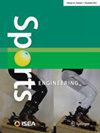Mechanics of wedge turns in alpine skiing
IF 1.4
Q3 SPORT SCIENCES
引用次数: 0
Abstract
A simple approximate theory of snow machining is applied to modelling successive wedge turns of alpine skiing. The model involves predefined control functions describing skier’s control over the turns via angle of attack, edge angle and loading of the skis. To demonstrate the model’s potential, reasonable control functions with a small number of free parameters are designed and used in attempt to reproduce the data obtained in a previous field study by other researches. The results are in semi-quantitative agreement with the data. In particular, the model explains the nature of the abnormally high values for the “coefficient of friction” deduced in that study. Future field studies of wedge turns should aim at measuring the angle of attack, edge angle and loading of the skis. This will allow to determine the control functions from the experimental data and hence to conduct a more stringent verification of the model.高山滑雪中楔形转弯的力学
将雪加工的一个简单近似理论应用于高山滑雪连续楔形转弯的建模。该模型包括预定义的控制函数,描述滑雪者通过迎角、边缘角和滑雪板负载对转弯的控制。为了证明该模型的潜力,设计并使用了具有少量自由参数的合理控制函数,试图重现其他研究在先前的现场研究中获得的数据。结果与数据半定量一致。特别是,该模型解释了该研究中推导出的“摩擦系数”异常高值的性质。未来对楔形转弯的实地研究应旨在测量滑雪板的迎角、棱角和载荷。这将允许从实验数据中确定控制函数,从而对模型进行更严格的验证。
本文章由计算机程序翻译,如有差异,请以英文原文为准。
求助全文
约1分钟内获得全文
求助全文
来源期刊

Sports Engineering
SPORT SCIENCES-
CiteScore
2.40
自引率
17.60%
发文量
23
期刊介绍:
Sports Engineering is an international journal publishing original papers on the application of engineering and science to sport. The journal intends to fill the niche area which lies between classical engineering and sports science and aims to bridge the gap between the analysis of the equipment and of the athlete. Areas of interest include the mechanics and dynamics of sport, the analysis of movement, instrumentation, equipment design, surface interaction, materials and modelling. These topics may be applied to technology in almost any sport. The journal will be of particular interest to Engineering, Physics, Mathematics and Sports Science Departments and will act as a forum where research, industry and the sports sector can exchange knowledge and innovative ideas.
 求助内容:
求助内容: 应助结果提醒方式:
应助结果提醒方式:


